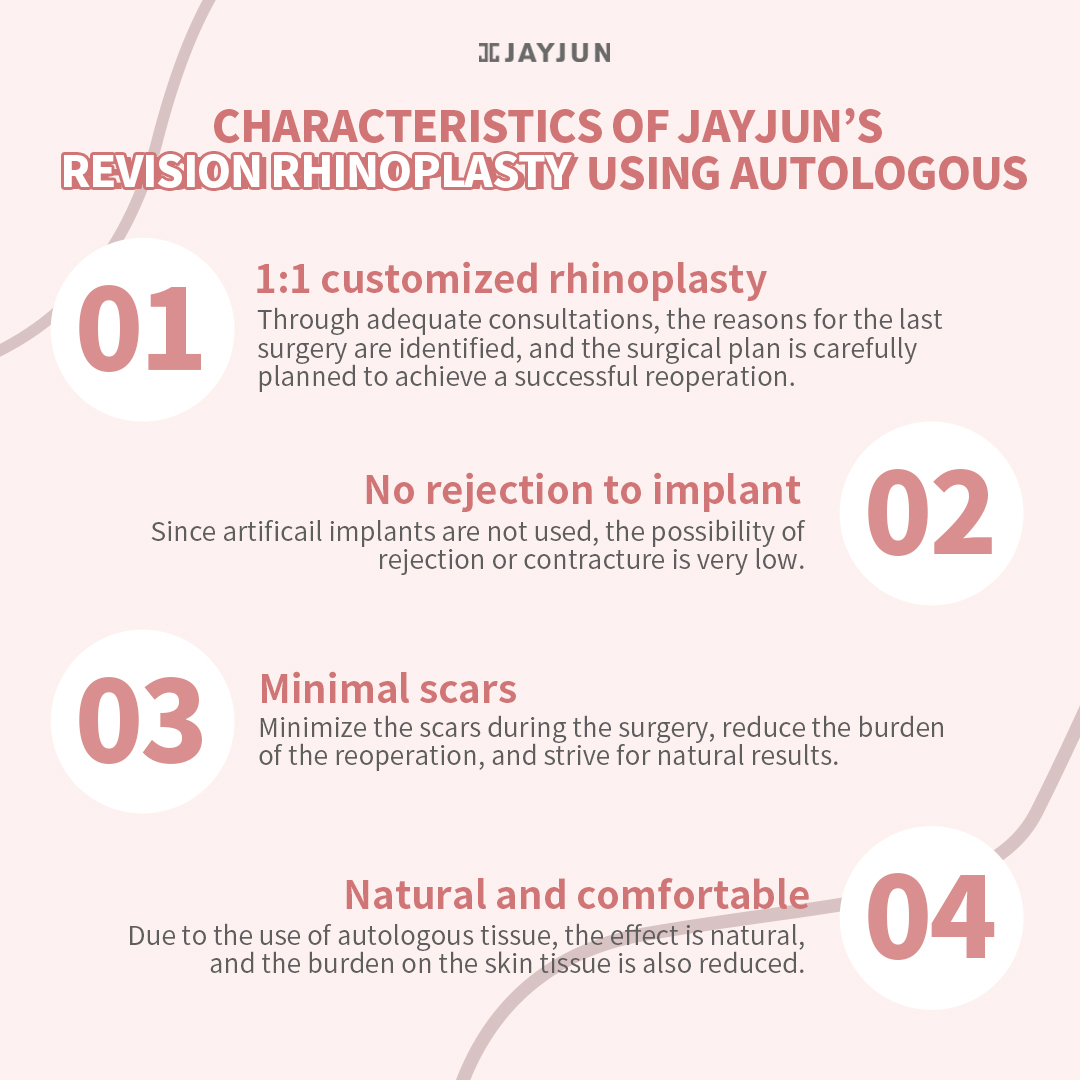Safely perform revision rhinoplasty
with autologous tissue
The nose in the middle of the face affects the impression of a person's face, and also has a great influence on the profile. Some people feel distressed by the shape of the nose, such as the low or wide bridge of the nose, which is not in balance with the overall face. Many people are dissatisfied with their noses and have undergone rhinoplasty. However, more and more people are considering revision rhinoplasty for various reasons such as dissatisfaction, curved nose, reflective protease and inflammation. Therefore, most people who come to Jayjun want to use #AutologousTissue for revision rhinoplasty. By using only autologous tissues such as dermis and cartilage and not using artificial materials, it is possible to reduce concerns about side effects and improve the overall facial impression by beautifully achieving facial balance that cannot be achieved by previous surgery.
Revision rhinoplasty can be said to be a very difficult surgery, because the first rhinoplasty has damaged a lot of tissue or extra work such as removing the protease may be required. Since it is more difficult than the first surgery, more reoperations can be avoided if the revision rhinoplasty is performed in a place with rich experience in reoperation and familiarity with the anatomy of the nose.
In particular, the #RevisionRhinoplasty using autologous tissues performed in Jayjun is very satisfactory because it can obtain a high natural nose without using artificial implants. By using autologous tissue, a nose that is as natural as the original nose can be created. In addition, because foreign objects such as implants are not used, the probability of side effects is low. If you are resistant to artificial implants, have suffered side effects from implants, or have allergic reactions to implants such as silicone, using autologous tissue can bring safer and more satisfactory results. If the nose is tall, long, or short due to previous surgery, or the nose turned to an unturned nose or a hooked nose, revision rhinoplasty using #AutologousTissue is a suitable method to improve the shape of the nose.
Generally, autologous tissues used for revision rhinoplasty include septal nasal cartilage and ear cartilage. Septal nasal cartilage is the autologous cartilage most commonly used for rhinoplasty. It is collected from the inside of the nose, so the risk of injury can be reduced. It is suitable for situations where the bridge of the nose needs to be raised or the nose needs to be lengthened. When the septal nasal cartilage is insufficient, ear cartilage can be used. Because the ear cartilage is soft and thick and the cartilage is abundant, it can create a natural nasal tip.
Everyone knows the importance of angles and lines to improve the nose. In order to create the ideal nose shape, not only the skill of the medical staff is important, but you also have to clearly communicate your requirements. Therefore, it is important to express your needs, carefully check the condition of your nose, and have sufficient consultation on how to perform the surgery.
Therefore, we not only have medical staff with skills and professional knowledge, but we also provide suitable solutions considering everyone's nose. In addition, the timing of revision rhinoplasty is also very important. For example, a revision rhinoplasty can be performed 3 months after the first rhinoplasty, but in most cases, the nasal tissue will not be sufficiently stable until the sixth month. It can be said that the most suitable time for #RevisionRhinoplasty is at least 6 months after first surgery. As everyone's situation is different, it is recommended to make a decision after full consultation.
A hasty decision may cause more problems, so we recommend that you undergo a revision rhinoplasty in a regular hospital after the skin tissue of the surgical site is completely restored.
If you are planning a #RevisionRhinoplasty , please check the reviews of people who have actually performed the surgery on our official website and find the best method for your revision rhinoplasty.
"If I keep touching my nose since I was a child, will my nose become taller?"
See more details on Jayjun’s YouTube channel.






Comments
Post a Comment